Magazine
Design incorporates objects, people,
ideas based on the small pleasures of everyday life.
Meet your Beautiful design world with the DDP Design Fair.
-

What is former Apple designer Jony Ive up to now?
Engaged in various exciting and meaningful collaborations of course!For the first time in his career, Jony Ive has teamed up with renowned outerwear fashion house Moncler to design apparel. The result is an experimental collection that combines Moncler's garment manufacturing know-how with Jony Ive's industrial design approach.Since leaving Apple on June 28, 2019, former Apple chief designer Jony Ive, who spent nearly 30 years at the company and was instrumental in helping Apple become the world's leading consumer electronics company, has started his own design agency, LoveFrom, where he works with a wide range of clients, seeking “enjoyable and rewarding collaborations that focus more on who you design for than what you design."The simple, versatile, and practical 'Ive Design' jacket is made up of three layers - a down jacket, a field jacket, and a parka. The down jacket, which can be worn underneath the two top layers or on its own, is available in light yellow and off-white. The collared field jacket, which can be worn on top, is available in light blue and green.The poncho-style hooded parka can be worn over the previous two garments and is designed with magnetic duo buttons that have Moncler branding and snap on and off with a distinctive 'click.' As the outermost layer, the parka comes in a pale coral color.To faithfully translate Ive's design vision into reality, Moncler used a special technique where each garment is seamlessly cut from a single length of fabric that was woven specially for the collaboration. Furthermore, the garments were also sewn using a specialized Taslan machine to create a natural flow.Ive's collaborations do not end there. He also collaborated with his colleague and renowned industrial designer Marc Newson to design a giant barrel diamond ring. The ring was purchased by an anonymous bidder at a Sotheby's auction at the Design Miami fair for US$256,250 (about KRW 350,000,000), with proceeds going to the RED AIDS charity. The barrel diamond served as a publicity stunt to promote a new beginning for the diamond industry, one that is more sustainable through the use of artificial diamonds.In early 2023, the British royal family commissioned Ive to design a commemorative royal logo for the coronation of King Charles III. To convey a message of gentle British royal rule, Ive used the blue-red-white-tri-color design of the Union Jack with two-dimensional modern typefaces and graphics to embody the new era of the Carolingian Empire.Then, in July 2023, Ive celebrated the 50th anniversary of audio brand Linn's 1972 Sondek LP12 turntable with the Sondek LP12-50, a 21st-century upgrade that incorporates appliances from Germany's Braun and the stainless steel, laser-polished aesthetic of the Apple iPod he designed.Recently, Ive is reportedly collaborating with OpenAI, the tech company behind ChatGTP, to develop hardware designs that will allow generative AI models to become consumer electronics.Courtesy: Moncler, Courtesy: LoveFrom
2024-10-2460 -
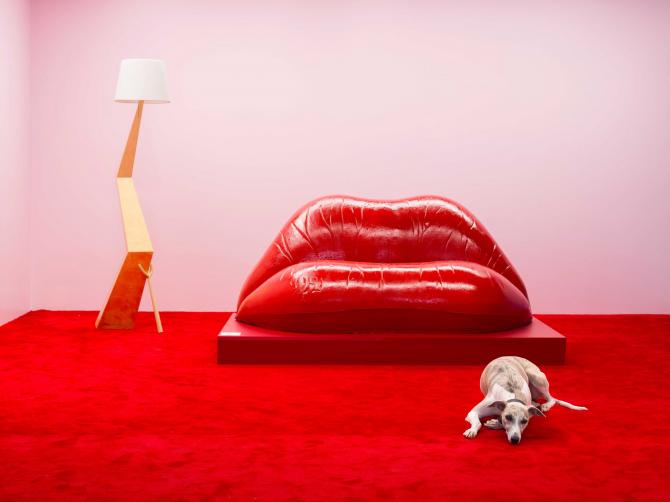
Salvador Dali's art reimagined by a surrealist interior designer
Salvador Dali's Furniture Design in ParisThis year marks the centenary anniversary of the birth of the Surrealist movement, which formed an important strand of European art history in the early 20th century. Since the beginning of 2024, the two cities that simultaneously declared themselves Surrealist in 1924 - Paris, France, and Brussels, Belgium - have opened a number of special exhibitions that revisit the movement and bring together works by Surrealist master painters from major museums and private collections around the world.In France, the Pompidou Center will temporarily close after the conclusion of the Olympic Games in Paris this August and will undergo a major renovation and remodeling over the next five years, starting in 2025. The former Pompidou Center, which boasted an avant-garde postmodern architecture designed by Renzo Piano and Richard Rogers in 1977, will be redesigned and renovated by French architectural firm Moreau Kusunoki Architectes and Mexican Frida Escobedo Studio starting next year.In the second half of 2024, the Pompidou Center's temporary exhibition space will host an extension of the exhibition “Salvador Dalí's Furniture,” curated by Galerie Poggi during the recent Paris Design Week (September 5-14), and will open to the public a selection of surrealist-inspired interior designs by designers who were either designed by the supreme rock star of surrealist painting himself or inspired by his art form. The exhibition is a collaboration between renowned Spanish furniture maker BD Barcelona Design, which has produced furniture for Salvador Dalí, Antoni Gaudí and Oscar Dusquets, and interior architect and curator Joan Madera.The signature piece of the exhibition, and one of the most recognizable, is the Saliva sofa. Shaped like a red lip, the Bocca Sofa, also known as the May West sofa after the actress May West's lips in one of Dalí's paintings, is an icon in the history of 20th-century design.Designed to order by Dalí in 1938 for the Englishman Edward James, a Surrealist collector and patron, the red modernist furniture, which he named Bocca, was originally an upholstery sculpture designed by Dalí to show off the triumph of Surrealist expression. Since 1972, it has been produced and sold by BD Barcelona Design in a synthetic polystyrene material.Dalí also designed several chairs. For example, the Invisible Personage (1935) armchair, handmade in the shape of a seated person, with sheepskin upholstery and a lamp on the backrest, is a replica of the chair depicted in his painting, Singularities. Other sculptures include Leda, an armchair with stiletto shoes, and the Muletas (red cloth tied to a bullfighter's rod), which is handmade to look like a lamp post connected by discolored bone.Dalí didn't just design expensive, rare handmade sculptures and interior works of art. He was also a popular high-end artist who had a profound influence on the pop art of the 1960s. It was Salvador Dalí who designed the Chupa Chups wrappers that we still see today near the checkout lanes of supermarkets and convenience stores, or in the candy aisle.An archetype of the 20th-century artist who proved that high art can be mass appealing, and that a unique look, persona, and self-promotion are as essential to success as creating great works of art, Dalí's designs have since been carried on by Andrée Putman, Shiro Kuramata, and Philippe Starck.
2024-10-1468 -
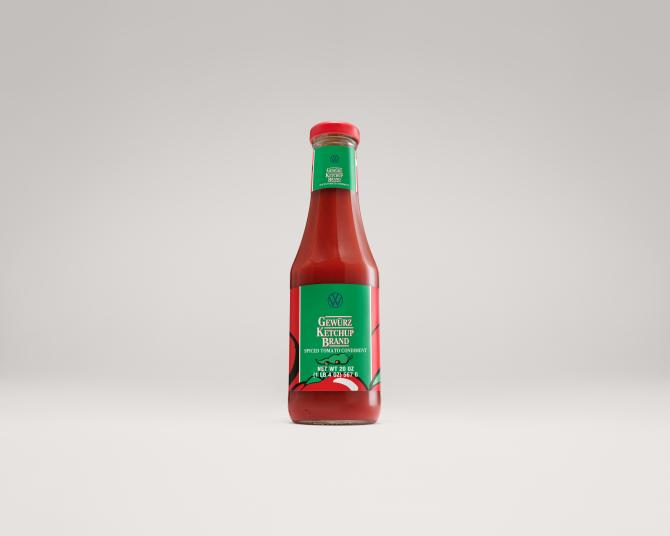
Volkswagen Expands into Lifestyle Branding
Volkswagen’s Secret Recipe “Gewürz Ketchup” Launches in the U.S.Volkswagen (VW), the German automaker reknowned for its iconic Beetle and Golf models, has ventured into the American lifestyle brand with the launch of its branded ketchup in the U.S. grocery market this fall. This year marks the 75th anniversary of Volkswagen's entry into the U.S. automobile market. To celebrate, Volkswagen America introduced the Gewürz Ketchup through ‘DriverGear’, the company’s lifestyle shop and merchandise platform. Released on September 23 in limited quantities, the ketchup was met with overwhelming enthusiasm, selling out almost immediately thanks to passionate Volkswagen fans.Volkswagen’s in-house food production dates back to 1973, supplying its 29 employee cafeterias with food items. One example is Volkswagen’s famed Currywurst sausage, which marked its 70th anniversary in 2023. Initially removed from cafeteria menus in 2021 as part of a vegetarian initiative, the Currywurst made a triumphant return following strong public demand. This beloved dish is so ingrained in Volkswagen’s culture that it is also sold in German supermarkets.A signature accompaniment to the Currywurst is Volkswagen’s Gewürz Ketchup, introduced in 1996. Designed specifically to pair with the Currywurst, the ketchup has a distinctive sweet and spicy flavor, setting it apart from typical American ketchup. Volkswagen’s marketing and consumer experience department describes the Gewürz Ketchup’s U.S. market launch as a successful PR initiative. It captures the joy of Volkswagen ownership in an everyday culinary staple, further reinforcing the brand’s emotional connection with its customers.
2024-10-0774 -
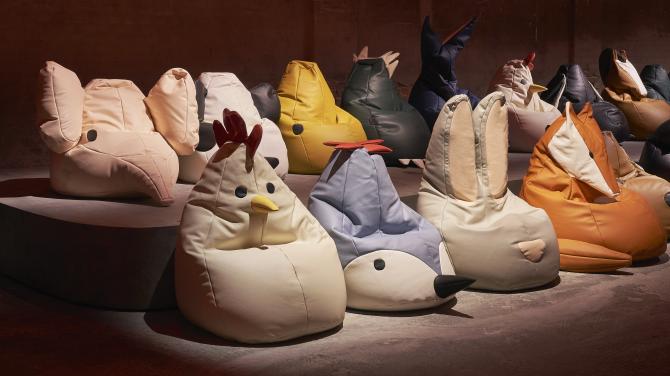
Bottega Veneta Redesigns the ‘Bean Bag’ Chair
Bottega Veneta x Zanotta Collaboration: 15 Animal-Themed Bean Bag ChairsAmong the highlights of this year’s Milan Fashion Week (September 17–23, 2024), which set the stage for 2025 Spring/Summer trends, was the enchanting animal-themed Bean Bag Chair exhibition curated by Bottega Veneta.The bean bag chair traces its origin back to 1968 with the Sacco Armchair, a classic design by Piero Gatti, Cesare Paolini, and Franco Teodoro for the renowned Italian furniture maker Zanotta. What could be more universally appealing than the shared sense of nostalgia and whimsical imagination that transcends age? 15 unique bean bag chairs inspired by animals debuted at Milan Fashion Week in partnership between Bottega Veneta x Zanotta. Using animals as the central theme, they reinterpreted modern classic piece as playful and emotive 21st century furniture, tailored to contemporary sensibilities.Matthieu Blazy, Bottega Veneta’s Creative Director and the mastermind behind the Bottega Veneta x Zanotta Bean Bag Chair exhibition, drew inspiration from the deep integration of companion animals in modern and social life. The designs feature beloved pets and farm animals like dogs, cats, rabbits, and chickens, alongside anthropomorphized creatures from fairytales like dinosaurs, whales, foxes, and beetles. Each design celebrate the joy and warmth animals bring to our lives, transforming them into cozy, inviting furniture that reflects their role as humanity’s closest companions.This collaboration successfully aligned Bottega Veneta, a premier Italian luxury fashion brand, with the 20th century Italian design icon, reinforcing its reputation in the broader context of global design history and tradition. At the same time, it solidified its image as a playful and innovative brand, leaving a lasting impression on consumers.Crafted with premium Italian leather and adorned with the brand’s signature Intrecciato handles for easy movement, these bean bags are as functional as they are luxurious. At the Milan Fashion Week exhibition, each design was released in a limited edition of just two pieces per animal, which was sold out almost instantly. Riding the wave of their success, the collection was subsequently made available on Bottega Veneta’s website. The animal-themed Bottega Veneta x Zanotta Bean Bags are priced between €6,000 and €8,000 (approximately KRW 9–12 million won).
2024-10-0493 -

Frankfurter Küche: Reviving 20th-Century Design Icon
Restoring the Historic Apartment of Margarete Schütte-Lihotzky’s, Pioneer of Bauhaus ArchitectureOn September 25, 2024, the Margarete Schütte-Lihotzky Center (MSL Zentrum) in Vienna unveiled the restored Frankfurter Küche—a pioneering achievement of 20th-century modern design. Faithfully reconstructed within the architect's former apartment, the kitchen offers a rare glimpse into Schütte-Lihotzky’s vision for functional, efficient urban living.Margarete Schütte-Lihotzky (1897–2000) was a trailblazing architect whose career spanned over eight decades. A key figure in the Bauhaus-inspired modernist movement, her contributions include designs for Vienna’s public housing, communal spaces for working women, and educational facilities and kindergartens. Throughout her life, she was a dedicated social activist, improving domestic spaces for lower-income families.Her former home at Franzensgasse 16 in Vienna’s 5th District, where she lived until her passing at the age of 103, has been transformed into the MSL Zentrum, a public museum. Following an extensive two-year restoration led by architects Christine Zwingl (MSL Center Director) and Renate Allmayer-Beck, the apartment has been returned to its original state, preserving its historical and architectural significance.Schütte-Lihotzky was among the first women to enter the male-dominated field of architecture in early 20th-century Europe. Her work in the 1920s Vienna Settlers Movement (Wiener Siedlerbewegung) reflected her commitment to improving housing and kitchen designs for low-income families. A committed social activist, she also endured imprisonment during World War II under the Nazi regime for her communist affiliations. After the war, Schütte-Lihotzky spent the latter half of the 20th century building her legacy. She contributed to architectural and design education, advised on public construction projects, and mentored future generations, particularly in countries like Russia, China, and Turkey, leaving an enduring impact on the global architecture and design landscape.Born into a wealthy family and leading a busy life as an architect, Margarete Schütte-Lihotzky was famously unfamiliar with cooking—a fact well-documented in architectural history. Despite this, Schütte-Lihotzky’s work on the Frankfurter Küche exemplifies her innovative approach to architecture and design. Created in the late 1920s as part of the Römerstadt Siedlung public housing project in Frankfurt, Germany, the kitchen was designed to maximize efficiency in small spaces. Measuring just 6.5 square meters, the design minimized movement while offering ample storage and practical layout solutions tailored to the lives and needs of urban women.The restored Frankfurter Küche at the MSL Zentrum features many of the original elements Schütte-Lihotzky conceived, including green wallpapers, vibrant orange tiles, large two-tier wooden-framed windows, and meticulously recreated storage cabinets. Unique to this restoration is the inclusion of a pull-out worktable modified in her later years to accommodate her petite stature and mobility.The Frankfurt Kitchen, restored in its original form within the apartment where its creator, Margarete Schütte-Lihotzky, once lived, offers visitors to the MSL Center more than a visual exhibition. Christine Zwingl, the center's director, and Renate Allmayer-Beck, the restoration architect, emphasize that the kitchen is a fully functional space. From the refrigerator to the sink and electric stove, every appliance and fixture has been meticulously restored to working order, making the Frankfurter Küche both a historical artifact and a living demonstration of its groundbreaking design.
2024-09-28110 -
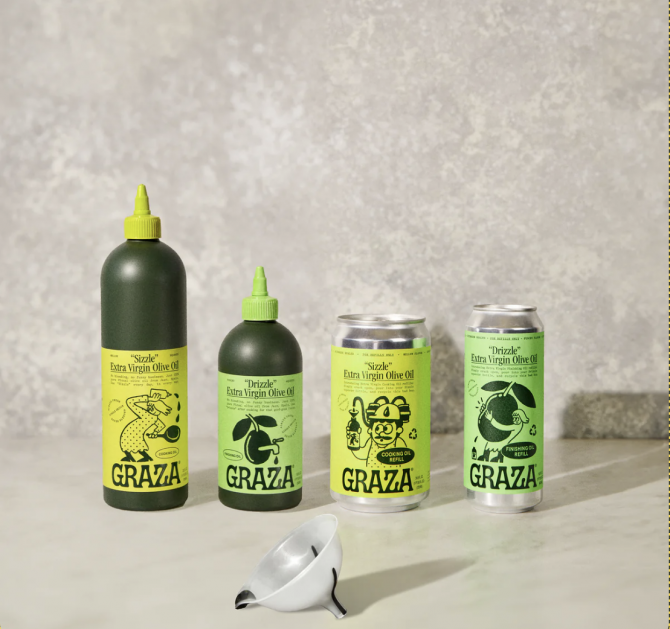
Breaking Stereotypes with Packaging to Boost Sales
The Design Innovation Behind Graza Olive Oil's Plastic Squeeze BottlesIn the spring of 2023, Andrew Benin, founder and CEO of the olive oil startup Graza (founded in October 2020), was stunned by a post he saw on Instagram while in Brooklyn. It was an advertisement from Brightland, a competitor in the olive oil sourcing and sales industry, featuring a new pizza oil packaged in a plastic squeeze bottle. Benin was outraged, claiming that the design of Brightland’s pizza oil bottle was a direct imitation of Graza’s own olive oil bottle design. He took to social media to voice his concerns, criticizing the copycat design.Interestingly, Graza’s signature product packaging—the flexible plastic squeeze bottles used for their “Sizzle” and “Drizzle” extra virgin olive oils—wasn’t an entirely original idea. Benin, after graduating with a degree in business, had an internship at a Michelin-starred restaurant in New York, where he observed chefs using plastic squeeze bottles to store and dispense sauces and seasonings. This practical approach to cooking led him to adapt the idea for consumer-friendly olive oil packaging.Typically, olive oil is produced in Southern European countries like Greece, Spain, and Italy, where olives are harvested and cold-pressed to extract the oil. Since olive oil is prone to oxidation when exposed to sunlight, it’s generally sold in dark glass bottles to protect it. However, Graza’s innovative plastic squeeze bottles broke this tradition, offering consumers a convenient, intuitive way to dispense the oil.Fast forward four years, Graza has grown into a $48 million annual revenue company. Its products are now sold in major U.S. supermarket chains like Whole Foods, Walmart, and Target, quickly gaining market share and outperforming competing olive oil brands, thanks in part to the bold packaging design and effective marketing strategies.At the heart of Graza’s appeal is its distinctive branding. The bright yellow and green squeeze bottles, with playful, cartoon-inspired designs, stand out on shelves and countertops. Their ergonomic design makes it easy to dispense oil, whether for cooking or as a finishing drizzle. Graza has also cleverly marketed its oils as two distinct products. The "Sizzle" olive oil, priced at 17$, is marked with a yellow label and features the drawing of a female chef drizzling oil from a frying pan, signaling that it's the ideal oil for high-heat cooking. The green-labeled "Drizzle" oil is intended for use as a finishing touch on dishes, such as salads. The separation of olive oils into two distinct categories—one for cooking and the other for drizzling—has proven to be a smart marketing move. By challenging the long-standing convention that one bottle of olive oil should serve both purposes, Graza has introduced a new, modern dining culture where kitchens and tables alike are equipped with two separate oils for different needs. In a competitive industry where product ideas and packaging designs are often quickly copied, Graza has managed to carve out a unique identity that resonates with consumers and disrupts the traditional olive oil market.
2024-09-1978 -
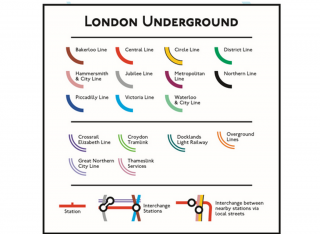
Dr. Maxwell Roberts Redesignes the IIconic London Underground Map
A Circular Visualization of the 'London Underground'Dr. Maxwell Roberts, a psychology lecturer at the University of Essex, has gained attention for his innovative redesign of the London Underground map, one of the city’s most iconic design elements. The most notable difference between Roberts’ new “London Underground” map and the traditional one is its use of a concentric circles to represent various tube lines. Previously, the map designed by Harry Beck became famous for its effective use of straight lines and geometric simplicity to represent the complex web of over 300 London Underground stations. By placing stations along a grid, Beck’s map made the labyrinthine system much easier to navigate. This map became a global standard for metro maps due to its ability to simplify the geographical complexities of the network. Dr. Roberts began his project to share a fresh, circular perspective on the London Underground map with the city’s residents back in 2013. His online project, which began with mapping out the distribution of stations around Tottenham Court Road and Oxford Circus, quickly went viral, attracting over a million participants within 24 hours. The initiative, known as the "New London Underground Map Project," allowed Londoners to engage with and provide feedback on the new design. The London Underground map, designed by Harry Beck in 1933, represents the locations of stations using straight lines at 45-degree angles. This design simplifies the geographical relationships of the stations, making it easier for users to understand the layout and proximity of stations. This standardized design has been widely adopted as a model for transportation maps everywhere. Dr. Roberts, however, argues that a circular, color-coded path would be more intuitive for travelers. For example, busy hubs like Oxford Circus, where 10 lines intersect, could be better represented with a circular layout and color-coded lines. This approach offers greater clarity and a stronger visual appeal. Despite widespread positive feedback from Londoners via social media platforms like LinkedIn and Twitter, Transport for London (TfL) has remained committed to the century old design by Harry Beck. This raises a key question: Will the city embrace the public’s call for a new map design that better serves the evolving needs of its transport system, or will it continue to preserve Beck’s iconic design? The outcome of this decision is a critical political and social moment, and all eyes are now on the London government to see which direction it will take. For further details on Dr. Maxwell Roberts' new London Underground map design, visit his website: http://www.tubemapcentral.com/
2024-09-04147 -
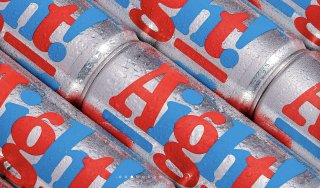
Candy-Inspired Beer Branding and Packaging Design
PangPang Pusher BeerIn an era where consumers are constantly on the lookout for bold and innovative beverages, Swedish craft brewery PangPang Pusher has raised the bar with creative beer can designs that perfectly reflect their lineup of fruity, fun flavors. The journey began in 2018 when PangPang Pusher introduced its first beer—a peach-flavored IPA—to the Swedish market. Since then, it has steadily expanded its range of flavors to include strawberry, piña colada, mango habanero, pink grapefruit, passion fruit, blackberry, yuzu elderflower, and watermelon. Even the name “Pusher,” which translates to "bootlegger" or “smuggler,” reflects the brand’s cheeky and unconventional spirit. To bring this vibe to life, Swedish graphic designer Jens Nilsson crafted a dynamic packaging design that encapsulates the brand’s zest and vibrancy. His approach uses lively pastel shades to mirror the tangy, refreshing qualities of each flavor, creating a visual identity as bold as the beer itself. Nilsson’s designs are all about striking the perfect balance between simplicity and personality. By combining soft pastel tones with bold illustrations, he ensures the logo and product details are clear and easy to read. The can is wrapped with three-panel labels that add depth and movement to the design, while a metallic, rectangular background—reminiscent of a plastic bag filled with fruit—creates a visual impression of transparency and freshness, as if offering a sneak peek inside the bottle. In today’s beverage market, where global giants dominate with mass-produced aesthetics, the collaboration between Nilsson and PangPang Pusher proves how small, independent brands can leverage bold design to stand out. Their distinctive branding strategy not only elevates their presence but also positions them as a vibrant, memorable alternative to mainstream products. This partnership showcases the transformative power of thoughtful, creative packaging: a visual language that tells a story, captures attention, and ultimately enhance brand recognition. PangPang Pusher’s success is a testament to how the right design can turn a small brewery into a standout player in a crowded market.
2024-08-2782







